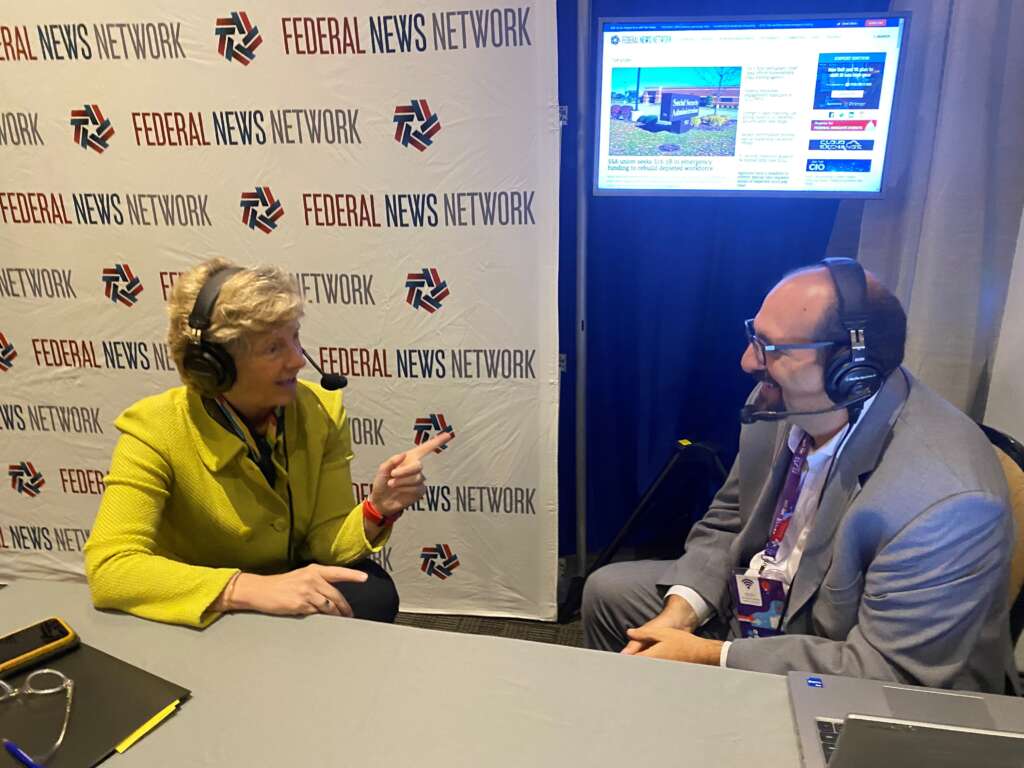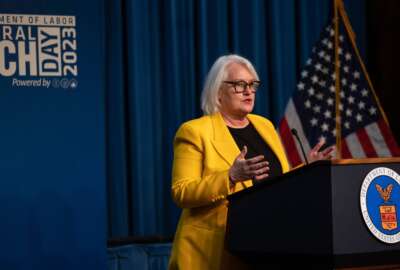GSA: 75 years of adapting to the changing needs of agencies
Robin Carnahan, the administrator of GSA, explains why the agency’s mission has remained the same over the last 75 years, but how it goes about has changed.
When President Harry Truman created the General Services Administration on July 1, 1949, its first project was a doozy.
Truman charged this new agency with overseeing a major renovation of the White House.
“The White House was kind of a mess. At one point, the piano leg fell through the floor, and that was really the precipitating event of why Truman said we have got to do something about this,” said Robin Carnahan, the administrator of GSA, in an interview with Federal News Network. “I love this story. GSA kept all of the historic outside part of the White House, but the interior was completely gutted. But in order to make sure that we preserved the historic nature of it, we actually took apart the bulldozers that were needed to do the gut renovation and piece-by-piece we put them back together once they got them through the doors, which I think just speaks to how much passion there is about keeping things historically accurate and taken care of. Truman lived in Blair House most of his time in office, and that’s how that renovation got done.”
The White House Historical Association has a great photo gallery about the Truman White House renovation.
GSA’s initial project foretold the role it has played over the last 75 years.
It would be easy to argue that GSA is the most important agency in all of government.
Just look at all the areas GSA touches:
- GSA owns and leases roughly 363 million square feet of space in more than 2,200 communities across the United States.
- 8,250 leased or owned buildings
- In fiscal 2023, the Federal Acquisition Service crossed $100 billion in total business volume for the first time in GSA history.
- During 2023, GSA awarded more than $3.3 billion in contracts to small businesses and more than $1.3 billion to small disadvantaged businesses. That’s more than 50% of GSA’s eligible spending in the small business category.
- A leased fleet of more than 230,000 vehicles
- Government employees across all branches of government and around the world rely on GSA SmartPay — with more than 4.5 million accounts including the Department of Defense, civilian agencies and Congress.
- Login.gov supports over 10 million monthly active users across 50 agencies and states. There are now over 100 million Login.gov accounts.
- As of May 2024, the United States Web Design System (USWDS) had 94 agencies, 18% of Login.gov sessions, 1,635,248,488 page views per month (371,362,361 sessions per month).
- The GSA per diem page receives more than 50,000 visitors each day, making it GSA’s most visited webpage.
Many of the things GSA does goes unnoticed to a certain extent. It’s like electricity or water, you only notice when things aren’t working, but otherwise you expect the plug to give you electricity and the faucet to give you water, and when they do, you don’t think about it.
There are 12,000 employees who come to work every day to make sure the buildings are maintained, the acquisition systems are available and the vehicles are gassed up and ready to go.
Of course, let’s not be Pollyanna about GSA. There are federal buildings that need a lot of work. The contracts they run aren’t always perfect and the technology that underlies key governmentwide systems still may need some upgrades.
But it’s clear over the last 75 years, GSA’s role in making the government run has been and will continue to be critical. President Joe Biden recognized GSA’s role in a July 1 letter, thanking the employee, past and present, for keeping the country running.
I sat down with Carnahan to talk about GSA’s impact on the government over the last 75 years, how they celebrated their special day — it’s unclear if there was cake — and, most importantly, how her team is setting the agency up for another 75 years of success.
FNN: How did you celebrate GSA’s 75th anniversary?
Carnahan: I did go to the Truman Library in Independence, Missouri, and sat down with the head of the Truman Library and their chief historian. We had a great conversation, several hundred people showed up to talk about the importance of GSA why President Truman decided to establish it in the first place, and what the impact has been over the years. So, that was a lot of fun.

The thing that is really heartening when I read back through the Hoover Commission report, which is what established GSA in the first place, was the section on having a general administration of General Services. What I love is that the purpose of Truman establishing this in the first place was for efficiency and to make government work better, and to save money. He had been an investigator and had the committee that was investigating fraud and abuse, and government and waste. He had seen the expansive growth of government after World War II, and the executive branch was not particularly well organized. It just grew over time. So that’s what the Hoover Commission was about: how do you actually structure the executive branch to make it work better for the American people? GSA was a big part of that. Originally, that was about how do you deliver for people effectively, and originally that was about buildings because that’s how you got your government services. You showed up in a building and it was also about acquisitions because there were lots that the government needed to buy.
FNN: From your perspective of someone who’s been watching GSA, now runs GSA, what have you seen and what have you heard from longtime GSA career staff about how things have changed?
Carnahan: One of the original things that GSA was put in charge of, after Truman established in 1949, was the renovation of the White House. The White House was kind of a mess, and at one point, the piano leg kind of fell through the floor. That was really the precipitating event of why Truman said we have got to do something about this. So, GSA, and I love the story, kept all of the historic outside part, of course, of the White House, but the interior was completely gutted. But in order to make sure that we preserve the historic nature of it, they actually took apart the bulldozers that were needed to do the gut renovation and piece-by-piece put them back together once they got them through the doors, which I think just speaks to how much passion there is about keeping things historically accurate and taken care of. Truman lived in Blair House most of his time in office. That’s how that renovation got done.
So early on, it was really about buildings. It was about how do you do that better, so that not every agency has to have a real estate or acquisition team. But over time, that obviously has changed. What hasn’t changed is that GSA’s mission, which is make government work better and save money doing it has always been there. How we deliver on that has changed as the times have changed. So, whether that’s adopting email or whether it’s the first agency to move those to the cloud, or whether what we’re doing now, around artificial intelligence and technology, that’s really about how do we deliver it better for the American people. I’m super proud of GSA’s ability to stick with the core mission, but also adapt with changes in the times.
FNN: Talk a little bit about the mission today and when people think about GSA and its mission, how has it morphed or evolved, but still having some key components to it?
Carnahan: I want to just say, again, I don’t think the mission has changed. It’s always been since the founding about how do you make government more effective and efficient. How do you how do you serve people better and save money? That has always been the core mission. What has changed is how we deliver on that mission, and so that that feels different today because, in large part, of technology, and because that’s become so much more important for every agency to integrate that into their service delivery. We are working on that and very focused on customer service and how we improve that, how we develop shared services to save money, and also deliver better how we reduce barriers to doing business with the government. These are all things that we focus on across the board. Obviously, since the Bipartisan Infrastructure Act and the Inflation Reduction Act were passed, we had new opportunities to do even more around a building efficiency. We are the largest have their largest commercial real estate portfolio in the country and when we can introduce sustainability and efficiency measures, that is leading by example, that’s helping move the market for everyone else in the country. That’s the thing GSA has done a lot throughout its history as well.
FNN: I’m glad you bring up federal buildings. I know there was recently hearings on Capitol Hill, looking at the portfolio without jumping down those paths, highlight a few things that are that you all are working on, currently and in the future about federal buildings, how to improve sustainability efficiencies, but also just how to make them better for employees as they return to the office as more employees live in this hybrid world.
Carnahan: The mantra that we have is fewer buildings, better buildings, which means we need to optimize the portfolio that we have to dispose of buildings that are not being productively used or not needed because those can be repurposed and used in their communities to have a positive impact on those communities. The other is, of course, about how do you make them more efficient? We know that most of most of the energy that is that is consumed in the building environments, a high percentage of that is lost through inefficiency, whether that’s in systems, whether that’s in the building envelope not being tight. When we can make improvements there, it saves money. It also is better for the environment. It also is a better climate inside the building for the people who are working in these buildings. That’s a big part of what we’ve been focused on all across the country. That helps drive the market for those kinds of clean technologies of the future.
The other thing we focused on is, how do we set these buildings up and these workspaces up to meet the needs of today in the hybrid work environment? Folks need different kinds of workspaces and so we have been testing those out. We’ve had the Workplace Innovation Lab at 1800 F [St. in Washington, D.C.]. We’re setting up those kinds of shared office spaces all around the country to make it easier for our agency partners to be able to get the kind of modern workspace that is how their teams want to work today.
FNN: How do you hope the buildings will look differently in 10 or 20 or even 50 years? How do you hope that that what you’re doing today will pay off in the short and the long term?
Carnahan: What I have really loved is seeing how the team across the country has just jumped into doing this because it makes so much sense. Whether I’m in Kansas City visiting a low embodied carbon concrete manufacturer or Carlisle, Pennsylvania, have focused on glass and how to make that more efficient, that helps the bottom line of the government by saving money. I always say that when we’re thinking about these sustainability investments in our own homes, you always have to have in the back of your mind, how long am I going to live here? What is the payback for this if I’m going to make this investment? Well, the government keeps these buildings for a long time. We’re not in the business of buying and selling buildings, all that much. We dispose of things eventually, but it takes a long time. So, for us, when we invest in sustainability and efficiency, it just hits our bottom line. It is a benefit. For example, we’re in the process of electrifying the Ronald Reagan Building in downtown Washington. It’s one of the biggest federal buildings in the D.C. area. It’s cutting energy consumption by 50%. That, to me, is a smart investment. So that’s the thing that I’m excited about is like not only can we make these investments that are smart for the public and for the government because it saves money and reduces emissions. But it also shows that we can help drive the market.
Over the years, GSA has had a tendency to be on the front edge of a lot of these things. Back in the 1960s before the Motor Vehicle Safety Act was signed by President [Lyndon] Johnson, the year before GSA put in vehicle safety standards for the vehicles that we were going to buy. You’ve heard of LEED certification. That was once a GSA and Defense Department decision to adopt that private sector developed standard for efficient buildings that became the gold standard across the world for how to have efficient buildings. So GSA’s market power, when it decides to do these things, is really significant.
Today, we’re thinking a lot about, and everybody’s talking about, AI. So, what does that mean for GSA’s role? Well, of course, we’re the folks who help agencies buy technology. But we need to have guardrails about what makes sense in the context of the government, how we take advantage of these things, but also reflect our values. We’re in the middle of that conversation as well.
FNN: I want to switch gears again and talk a little bit about the people of GSA. I know you’ll tell me, we have the best people, which you should. And I know you’ll tell me the Best Places to Work results demonstrated by the numbers and how good of a place GSA is to work, which is all good news. I’m interested also in understanding how you, from the role you sit in as a leader of GSA, continue to ensure that the workforce feels like the changes the evolution that is happening with them instead of to them. I think that’s probably the biggest challenge any manager has is, as you go through so much change, and it happens can happen very quickly. How to ensure that employees feel like they’re part of it?
Carnahan: I’m smiling about that question because I actually think our people are the ones who are driving the change. We’ve got just a fantastic workforce. I heard when we were doing all the 75th anniversary stuff that we have over 26 people who have been at GSA over 50 years, which is amazing to me. We’ve got almost 1,300 that have been in GSA for 30 years. So, we’ve got folks who understand the mission of the agency, which is fantastic. They have ideas about how to deliver better for customers. I spent a lot of my time listening to them and figuring out how we can use that feedback to make our services even better. To me, it’s just a real privilege to be able to work with the team there.
I’ve seen so much as I travel around the country that like by relying on our teams in the field, because like 70% of our people are outside of Washington, and 70% of our assets, more or less, are outside of Washington. When we get things like the Bipartisan Infrastructure Law and the Inflation Reduction Act, we get this infusion of money and it’s not people in Washington dreaming up how to spend that money. It is all coming from the people in the field about how they can deploy this in ways that have the biggest impact.
There’s one great example we have some funding for a thing called restorative sites that are about improving what’s happening in GSA as a better neighbor in communities. I was up in New Jersey not long ago to see how the area outside the federal building there, which is kind of a mess after 9/11 because the roads got blocked off, the concrete crumbled and it was unclear who was in charge of the street, whether it was a city or whether it was the feds. We put some money into this project and it’s going to completely change that downtown area and make it into more of a plaza area, so that the community can use that more like a park around the federal building. When we put out the call for those kinds of investments, we had over 80 proposals submitted from around the country, much more than we had funding for. But I say this too, just as a reflection of the teams we have and communities know what GSA can do to deliver better for people. And I’m super proud of that.
FNN: Let’s end with that question is the continuous improvement piece. The measurement of that? How do you from where you sit, as the administrator, really look at the progress you’re making? How do you measure? Hey, how are we better today than we were yesterday? Are we better this week than we were last week? What are some of those if you can be low specific key measurements that you really focus on? Yeah,
Carnahan: Just in terms of employee satisfaction in the workforce, I’m super proud of our ranking in the Best Places to Work. We jumped two spots up to up to number two among midsize agencies. I’m very competitive and we keep talking about how we get to number one. We have been very intentional about trying to get feedback from our teams about how we really can unlock the power of our workforce and have them have them feel agency to get this stuff done. We’re going to continue to do that. We do all the surveys all the time. But none of those matter unless you’re actually carrying out the suggestions. So that’s the thing that we’re very focused on.
When it comes to particular mission goals, we’re going to continue to try to push toward optimizing the federal footprint. We know we can do better on that we know we can have fewer buildings and better buildings and save money and have a better climate for the employees across the government that are in federal facilities. So that’s a top priority.
We know that we can keep reducing the burden on folks who whether it’s federal agency partners or whether it’s the private sector, who wants to do business with the government. We are very specifically measuring progress on that. Then, let’s talk about shared services, we’d like to increase the use of those. That’s a thing that we have lots of metrics around, but also how we reduce the burden on businesses that want to do things with GSA. I’m super proud, by the way of our work with small businesses, which I will say forgot to mention at the outset, was one of Truman’s ideas as well, that he wanted to make sure that the small businesses had a fair shot in doing business with the government. We very closely monitor our small business goals and are hitting those. They’re ambitious, and we’re hitting them and I’m proud of that.
And then the sustainability and efficiency part that we can play to really drive that triple win toward the clean energy economy that creates jobs and innovation in America saves money and helps our kids. Those are the things that we have a lot of focus on measuring.
Copyright © 2024 Federal News Network. All rights reserved. This website is not intended for users located within the European Economic Area.
Jason Miller is executive editor of Federal News Network and directs news coverage on the people, policy and programs of the federal government.
Follow @jmillerWFED






